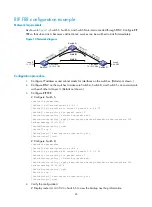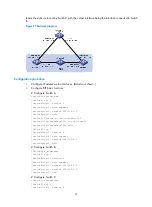
34
Step Command
Remarks
1.
Enter system view.
system-view
N/A
2.
Enter RIP view.
rip
[
process-id
] [
vpn-instance
vpn-instance-name
]
N/A
3.
Specify a RIP neighbor.
peer
ip-address
N/A
4.
Disable source address check
on incoming RIP updates.
undo validate-source-address
Not disabled by default.
Configuring RIP-to-MIB binding
This task allows you to enable a specific RIP process to receive SNMP requests.
To bind RIP to MIB:
Step Command
Remarks
1.
Enter system view.
system-view
N/A
2.
Bind RIP to MIB.
rip mib-binding
process-id
Optional.
By default, MIB is bound to RIP
process 1.
Configuring the RIP packet sending rate
RIP periodically sends routing information in RIP packets to RIP neighbors.
Sending large numbers of RIP packets at the same time may affect device performance and consume
large network bandwidth. To solve this problem, specify the maximum number of RIP packets that can be
sent at the specified interval.
To configure the RIP packet sending rate:
Step Command
Remarks
1.
Enter system view.
system-view
N/A
2.
Enable a RIP process and
enter RIP view.
rip
[
process-id
] [
vpn-instance
vpn-instance-name
]
N/A
3.
Configure the maximum
number of RIP packets that
can be sent at the specified
interval.
output-delay
time
count
count
Optional.
By default, an interface sends up to
three RIP packets every 20
milliseconds.
Configuring RIP FRR
When a link in a RIP network fails, the traffic is interrupted until RIP completes routing convergence based
on the new network topology.
You can enable RIP fast reroute (FRR) to reduce traffic recovery time.






























